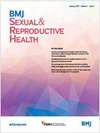YouTube和单杆避孕植入物:内容分析
Q Medicine
Journal of Family Planning and Reproductive Health Care
Pub Date : 2017-01-20
DOI:10.1136/jfprhc-2016-101593
引用次数: 20
摘要
背景由于互联网已成为避孕信息的重要来源,YouTube.com是访问量第二大的网站,我们分析了YouTube上的避孕植入视频的内容和临床准确性。方法使用术语“避孕植入物”、“Nexplanon”和“Implanon”,根据相关性和浏览次数确定YouTube上排名前20的结果。在排除重复后,包括了英文的单杆植入视频。视频被归类为提供专业或患者视角。与会者注意到了意见、持续时间和意见。视频的可靠性、全球质量等级以及对植入物的评价是积极的还是消极的。评估了评分者之间的一致性。结果共检索到120个视频;52人符合审查条件。专业视频不到23%;大多数患者报告了患者经历(46%的患者有感言,27%的患者有实时手术视频,4%的患者有其他经历)。患者视频的发布时间明显长于专业视频(364比188 天,p=0.02),不太可靠(p≤0.0001),总体质量较低(p<0.0001)。约61%的植入物评价视频被评为“积极体验”,评分者之间的一致性非常好(κ=0.81)。所有评价都提到了副作用,通常是不规则出血和插入不适。少数人(26%)报告了错误信息。结论本研究发现,YouTube上大多数与避孕植入物有关的信息都是准确的,都是从患者的角度呈现的,并促进了该方法的使用。本文章由计算机程序翻译,如有差异,请以英文原文为准。
YouTube and the single-rod contraceptive implant: a content analysis
Background Since the internet has become an important source of contraceptive information with YouTube.com as the second most visited site, we analysed contraceptive implant YouTube videos for content and clinical accuracy. Methods Using the terms ‘contraceptive implant’, ‘Nexplanon’ and ‘Implanon’, the top 20 results on YouTube by relevance and view count were identified. After excluding duplicates, single-rod implant videos in English were included. Videos were classified as providing a professional or patient perspective. Views, duration and comments were noted. Videos were rated for reliability, global quality scale and whether they were positive or negative about the implant. Inter-rater agreement was measured. Results A total of 120 videos were retrieved; 52 were eligible for review. Less than 23% were professional videos; the majority reported patient experience (46% testimonials, 27% real-time procedure videos, 4% other). Patient videos had been posted a significantly longer duration of time than professional videos (364 vs 188 days, p=0.02), were less reliable (p≤0.0001) and were of lower global quality (p<0.0001). Some 61% of implant testimonial videos were rated as ‘positive experiences’ and inter-rater agreement was very good (κ=0.81). All testimonials mentioned side effects, commonly irregular bleeding and discomfort with insertion. A minority (26%) reported misinformation. Conclusions This study found that most of the information on YouTube pertaining to contraceptive implants is accurate, is presented from the patient's perspective, and promotes the method's use.
求助全文
通过发布文献求助,成功后即可免费获取论文全文。
去求助
来源期刊

Journal of Family Planning and Reproductive Health Care
OBSTETRICS & GYNECOLOGY-
CiteScore
0.84
自引率
0.00%
发文量
0
审稿时长
>12 weeks
期刊介绍:
The trading of Professional, Managerial & Healthcare Publications Ltd has been transferred to its parent company, Keyways Publishing Ltd.
 求助内容:
求助内容: 应助结果提醒方式:
应助结果提醒方式:


